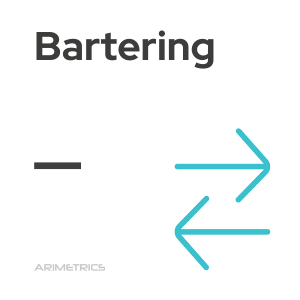
Definition:
Bartering is a direct exchange of goods or services without the use of money. The exchanged good is called a barter.
Bartering is frequently used in television media, with the television network ceding a part of its advertising space to a certain advertiser in exchange for the brand delivering a product or service, being considered a barter between the medium and the advertiser.
It is also used on some websites, and can consist of both banner exchanges, links, sponsored posts or sponsorship exchanges.
Bartering in the Media
Bartering is commonly used in television media, where a television network gives part of its advertising space to an advertiser in exchange for products or services. This exchange is considered a barter between the media and the advertiser, allowing both parties to benefit without a monetary outlay. For example, a network may offer airtime to an automobile brand, which in turn provides vehicles to be used in the production of programs.
Bartering in the Digital Environment
In the digital realm, bartering is also used on websites and online platforms. It can include exchanges of banners, links, sponsored posts or sponsorships, where no monetary transaction takes place. Numerous websites act as exchange marketplaces, where organizations post advertisements to exchange products and services for other benefits, excluding the use of money. In the webmaster environment, it is common to exchange banners or links with the aim of improving web positioning, without any economic transaction.
In addition, bartering strategies have been developed with influencers and content creators on platforms such as Instagram and YouTube. In these cases, influencers receive products, meals at restaurants or stays at resorts in exchange for mentioning them on their social networks. This type of barter is beneficial for both parties: brands gain visibility and influencers get products or experiences.
Examples of Bartering
Television contests: Prizes consist of products provided by manufacturers, which are given to viewers in exchange for television exposure. This not only promotes the product, but also reduces program production costs.
Toy cartoons: These programs are created by brands and offered to television networks as a form of advertising to boost product sales. It works as a marketing strategy to capture the attention of children.
Benefits and challenges of bartering
Among the benefits of using barterlin we can mention:
- Resource efficiency: Allows companies to use their surplus products or services without spending money.
- Access to new markets: Companies can reach new audiences through strategic bartering partnerships.
- Flexibility: Offers a viable alternative for cash-strapped companies, allowing for continuity of operations and marketing.
Bartering, however, presents a number of challenges:
- Valuation: Determining the fair value of the goods or services exchanged can be complicated and subjective.
- Supply constraints: Not all products or services are suitable for bartering, which may limit exchange opportunities.
- Complexity of agreements: Establishing clear and fair terms for both parties may require detailed negotiations and well-defined contracts.
